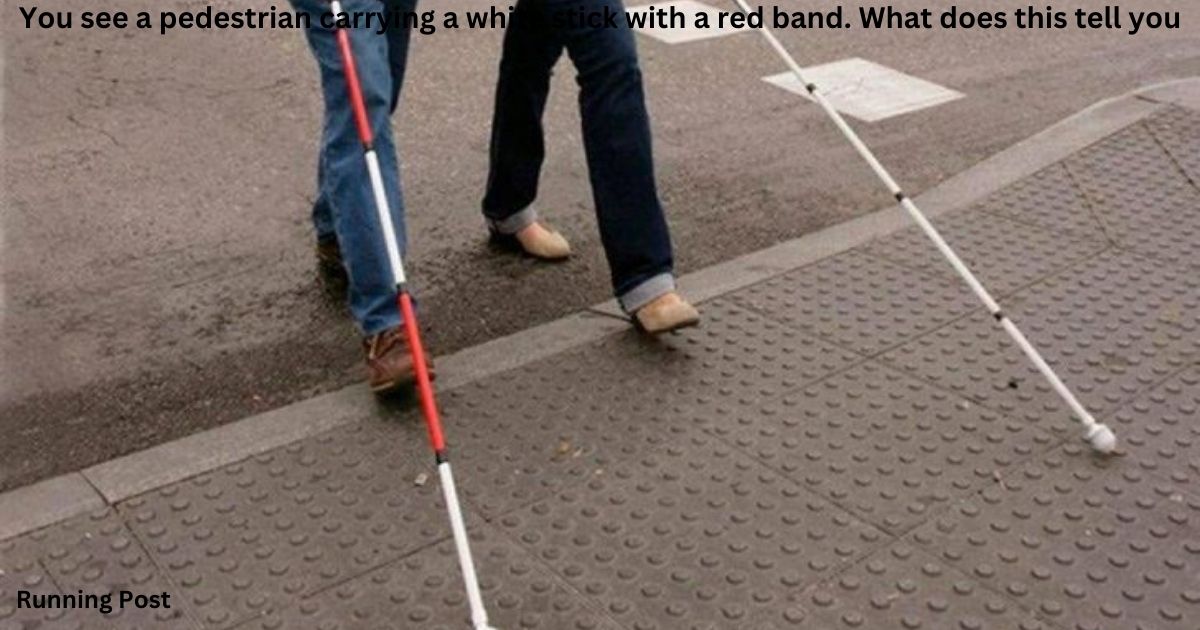| A: They’re deaf and blind | B: They’re deaf | C: They have limited mobility | D: They’re blind |
Understanding the You see a pedestrian carrying a white stick with a red band. What does this tell you?
Introduction
Overview of the White Stick with a Red Band
The white stick with a red band is a crucial tool for individuals who are both deaf and blind. This combination of disabilities poses significant challenges in mobility and communication, making specialized aids essential for their safety and navigation. The white stick, commonly associated with blindness, is equipped with a red band to indicate dual sensory impairments. This guide will explore the significance of this tool, its implications for pedestrians, and the necessary responses from drivers and other road users.
Importance of Recognizing Pedestrian Signals
Understanding and recognizing various pedestrian signals is vital for ensuring safety on the roads. Pedestrians with disabilities often rely on visual and tactile cues to navigate their surroundings. For drivers, acknowledging these signals helps prevent accidents and supports a more inclusive environment for all road users. The white stick with a red band is a specific signal that demands particular attention and respect from drivers.
Purpose of This Article
This article aims to provide a comprehensive understanding of the white stick with a red band, explain its meaning, and outline the appropriate actions drivers should take when encountering pedestrians using this tool. By the end of this guide, readers will have a clearer grasp of how to interpret these signals and contribute to a safer and more accessible environment for individuals with dual sensory impairments.
What Does It Mean When a Pedestrian is Carrying a White Stick with a Red Band?
Significance of the White Stick
The white stick is a well-recognized symbol for visually impaired individuals. It serves as a mobility aid, helping users detect obstacles and navigate their surroundings through tactile feedback. The stick is typically used by those who are blind or have severe vision impairment. Its white color denotes that the user has visual impairments, while its length and texture provide necessary sensory input for navigation.
Common Uses of White Canes
White canes are used in various ways, including detecting obstacles, measuring distances, and providing stability while walking. They are essential tools for individuals with visual impairments, allowing them to move independently and safely. The white cane’s design and use are standardized, making it a universally recognized symbol of visual impairment.
How the White Stick Indicates Blindness
The white stick signifies that the user is blind or has significant vision loss. It helps communicate to others that the person may have difficulty seeing obstacles or other potential hazards. When combined with a red band, this signal becomes even more specific, indicating additional sensory impairments, such as deafness.
Meaning of the Red Band
Why the Red Band is Used
The red band on the white stick serves as a clear indicator of dual sensory impairments. While the white stick alone signifies visual impairment, the addition of the red band specifically denotes that the individual is also deaf or hard of hearing. This added layer of information helps drivers and others understand that the pedestrian may not be able to hear approaching vehicles or other auditory cues.
Differentiating from Other Cane Indicators
In addition to the red band, other cane indicators might be used for different purposes. For example, a white cane with a red tip is often used by individuals with both visual and mobility impairments. The red band, however, is a distinct marker for those who are both blind and deaf, helping to prevent misunderstandings and ensure that appropriate accommodations are made.
What Does the Red Band on a White Stick Mean?

Purpose of the Red Band
The red band serves a specific purpose: it alerts others to the fact that the individual carrying the cane is both blind and deaf. This information is crucial for safety, as it helps drivers and pedestrians recognize that the person may require additional time or assistance when navigating their environment.
Historical Context and Development
The use of the red band on a white cane has evolved over time. Initially, white canes were primarily associated with visual impairments. However, as awareness of dual sensory impairments grew, the red band was introduced to provide a more accurate description of the user’s needs. This development reflects ongoing efforts to improve accessibility and safety for individuals with multiple disabilities.
Specificity of the Red Band for Certain Conditions
The red band is not a universal symbol but rather a specific indicator for individuals who are both deaf and blind. Its use helps ensure that these individuals receive the appropriate support and considerations they need in various settings, from pedestrian crossings to public spaces.
What Does It Mean If You See a Pedestrian Wearing Reflective Clothing and Carrying a Red Light?
Reflective Clothing and Red Light Indicators
Reflective clothing and red lights are additional tools used to enhance visibility and safety for pedestrians. Reflective clothing makes individuals more visible to drivers, especially in low-light conditions. A red light further increases their visibility and signals their presence to approaching vehicles.
Purpose of Reflective Clothing for Pedestrians
Reflective clothing is designed to make pedestrians more noticeable, particularly in dimly lit or poorly lit areas. It reflects light from vehicle headlights, helping drivers spot pedestrians from a distance. This is crucial for preventing accidents and ensuring that pedestrians are seen in time for drivers to react safely.
Significance of Carrying a Red Light
Carrying a red light serves as an additional precaution. The red light acts as a clear visual signal that helps drivers identify the presence of a pedestrian. This is particularly important at night or in low-visibility conditions, where reflective clothing alone may not be sufficient.
Combining Indicators
What It Tells Drivers and Pedestrians
When a pedestrian combines reflective clothing with a red light, it signals a heightened need for caution. For drivers, this combination indicates that the pedestrian is making a concerted effort to be seen, which should be met with increased awareness and reduced speed. For pedestrians, these tools enhance their safety by improving visibility and reducing the risk of accidents.
You Also Like It:
Which is the most vulnerable road user?
how much can stopping distances increase in icy conditions?
When may front fog lights be used?
Legal and Safety Considerations
What Must You Do When You See a Pedestrian with a White Cane in the Street Ahead of You in Florida?
Florida Traffic Laws Related to Pedestrians
In Florida, traffic laws require drivers to exercise extra caution when encountering pedestrians, particularly those using mobility aids like white canes. Drivers must yield the right of way to pedestrians in crosswalks and be prepared to stop if a pedestrian with a white cane is crossing the street.
Best Practices for Drivers
When approaching a pedestrian with a white cane, especially one with a red band, drivers should slow down and be ready to stop if necessary. It’s essential to be attentive and aware of the pedestrian’s movements, as they may not be able to react to traffic signals or sounds in the same way as other individuals. Ensuring a safe distance and being prepared to yield can prevent accidents and support a safer road environment for everyone.
Conclusion
Recap of Key Points
In summary, the white stick with a red band is a crucial tool for individuals who are both deaf and blind, providing important information to others about their sensory impairments. Understanding the significance of this indicator, along with other tools like reflective clothing and red lights, helps enhance safety and awareness on the roads.
Importance of Awareness and Responsiveness
Awareness and responsiveness are key to ensuring the safety of pedestrians with disabilities. By recognizing and appropriately responding to these signals, drivers can contribute to a more inclusive and safer environment for all road users.
Final Thoughts
Encouraging safe interaction with pedestrians and understanding their unique needs fosters a more considerate and accessible community. By being informed and proactive, we can all play a role in making our streets safer for everyone.
You Also Like It:
What part of the car does the law require you to keep in good condition?
Releated Posts
MAB Instructor Certification: Your Gateway to Professional Crisis Management Leadership
In today’s fast-evolving professional environments—especially in healthcare, mental health, education, and corrections—conflict and aggression can arise without warning.…
Freewayget.com: Your Ultimate Platform for Deals, Discounts, and Digital Products
Introduction to Freewayget.com In today’s fast-paced digital world, finding reliable platforms that offer authentic discounts, deals, and digital…
Affordable & Fast Embroidery Digitizing Services in Your Area
Embroidery digitizing services provide corporations, designers, and people with brilliant embroidery-equipped designs by means of changing art work…
Introduction to hdhub4u nit
In this article, we will delve into the details of hdhub4u nit, exploring its features, benefits, and why…

















